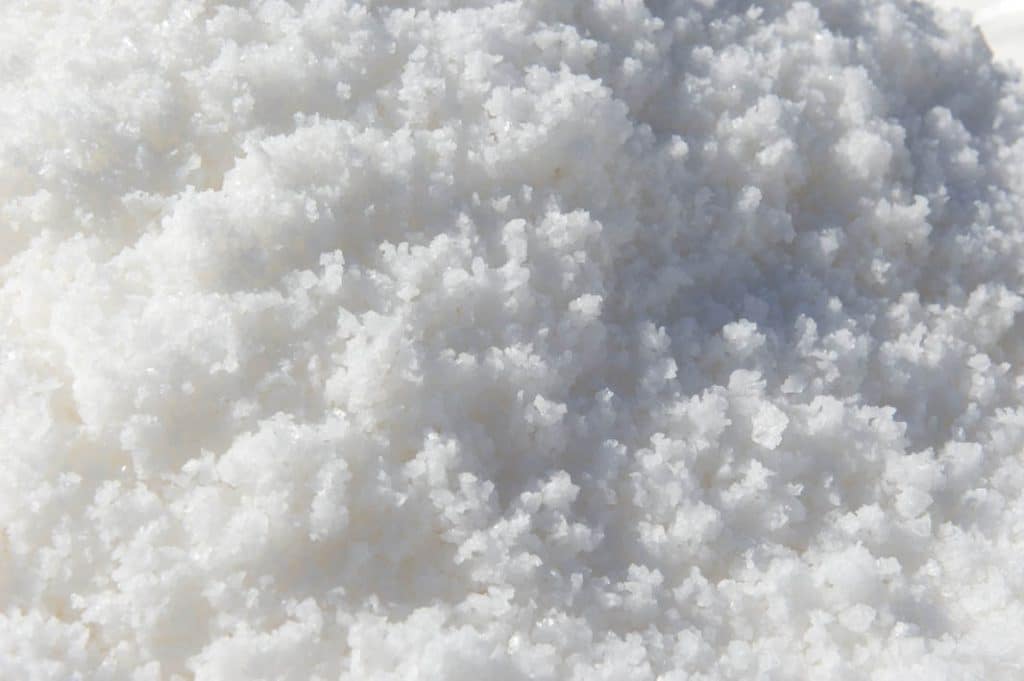One upon a time, the source
A long time ago, nestled in the heart of the Adour Basin, men discovered a source of water as salty as that of the Dead Sea and ten times saltier than seawater. The legend tells that a wounded wild boar was found at the edge of a small pond. It was snow-white and its hair covered with salt crystals sparkled like a thousand lights in the sun …

The salt and salt history of the Adour basin is closely linked to the salt city.
In Salies-de-Béarn, on the occasion of the salt festival which takes place every year during the second weekend of September, we honor the discovery of this precious treasure.
Salies-de-Béarn became Bearnaise at the end of the 12th century and the city of salt grew around the salt fountain gradually taking the characteristic shape of a snail. Everything is done to allow for transportation of the precious salt water from the fountain to the workshops as quickly as possible.
Salt, sacred symbil in civilizations
« Amicitia pactum salis », friendship is a salt pact
Since its discovery we venerate its virtues transmitted from generation to generation. Symbol of the bond of brotherhood and friendship, all over the world we share salt as bread.
Beliefs or superstitions, salt nourishes our imagination and is illustrated in the representations of the lifestyles of the times.
In Oloron-Sainte-Marie, the capital of Haut-Béarn, the magnificent sculpted portal of its 12th century cathedral, presents typical scenes from Béarn, representations of small trades such as cheese ripening, salmon fishing or the peler pork, preservation and salting. Many uses made possible by the use of salt from the Pyrenees of Salies-de-Béarn.
Salt conservation : a major role
Since the end of the prehistoric age, salt is the oldest ingredient used for food preservation and today salt is an essential element for health security.
The salt room once played a domestic role comparable to that of the freezer in our society. Salt was used to make canned goods in large terracotta earthenware such as the famous Gallic hams that traveled all over Europe. Many foods derive their names from the word salt: salted, salted, sausage.
Salting is a key stage in cheese making. Salt acts as a flavoring and preservative agent. It naturally absorbs moisture and ensures the transition between dripping and ripening. It is used to release the whey and thus helps stabilize the shape of the cheese. For each cheese, we choose a quality of salt. The salt of Salies-de-Béarn is mainly used for making the famous cheeses of the Pyrenees.
Salt and saltiinig, the historic union
For the dry salting technique of the famous Bayonne Hams, salt from Salies-de-Béarn is traditionally used. Fresh whole hams are rubbed and covered with a thick layer of salt before being placed in the salt pan.
To favor the flavor of the ham, it is essential to use a pure salt, very rich in mineral salts and trace elements. Bactericidal, the salt of Salies-de-Béarn has a very high penetration capacity that allows during the ripening period to obtain a soft and naturally pink flesh.
Origin
The richness of a water of marine origin
200 million years ago, when dinosaurs lived in lagoons and long before humans appeared, the disintegration of the supercontinent, Pangea, began.
During the Triassic period, in a torrid climate, shallow marine lagoons deposited, like a gigantic salt marsh, rich layers of salt. Protected by a sumptuous mantle of clay, they will be preserved for centuries of any pollution.
At the end of the Cretaceous and during the Tertiary era, 65 million years ago, the formation of the Pyrenees mountains will cause large fractures in the underground depths. The water very rich in salt, will sneak through these faults to get closer to the ground. This immense sheet of salt saturated with water will sleep in the depths of the Pyrenees, for centuries while preserving its original purity. It will be the source of salt deposits in the Adour basin.
From the Neolithic period, salt participated in the sedentarisation of nomadic hunters and acquired a high value for its rarity, its increasing use and its capacity to be stored. The salt is used for food, conservation and as money in large networks of exchange that take place.
From the Bronze Age around 1500 BC, in the Adour basin, men settled closer to this treasure in the marshy basin of Salies-de-Béarn. Gathered around a Castera sort of natural and collective habitat, men dig in the ground circular ovens for cooking earthen vases that heat the salt water. After evaporation of the water, the frustoconical vases are broken to collect the loaves of salt.
, les hommes s’installent au plus près de ce trésor, dans la cuvette marécageuse de Salies-de-Béarn. Réunis autour d’un Castéra sorte d’habitat naturel et collectif, les hommes creusent dans le sol des fours circulaires destinés à la cuisson des vases en terre qui permettent de chauffer l’eau salée. Après évaporation de l’eau, les vases tronconiques sont brisés pour recueillir les pains de sel.
The salt of the first men
The salt trade in the Gallo-Roman era
In ancient times, the salt trade grew more and more. Salt was used to salt, smoke or dry meat and fish, to season food but also to make canned food in large terracotta earthenware that travelled throughout Europe.
The Roman roads built of stone will for a long time be the main roads practical during all seasons for the transport of salt.
At that time, Salies-de-Béarn, already supplies the populations Béarnaises, Basques and Gascon and exports its salt by borrowing Lou Cami salié, the salt way in Béarnais, fragment of a prehistoric way along the Pyrenees and great commercial route practiced from west to east.
The time of revolts and revolutions
Between the 14th and the 17th century, salt requirements are exploding due to the sharp increase in population. Royal power sees it as a source of profit. From being a simple tax on salt, the gabelle becomes a state monopoly. Unfair and inequitable, the salt tax will increase smuggling and give birth in France to one of the largest smuggling movements: The false-saunage.
Abolished in 1790, the salt gabelle, will be abolished in 1946, after the Second World War.
A unique organization in France: The Corporation of the Stakeholders
In Salies-de-Béarn, the White Gold attracts more and more lust. The increase of the population and the increase of the rights holders provoke numerous conflicts and inequalities. As early as the 16th century, in the interest of justice, the Salisians founded an original organization, the Corporation of Neighbors or Corporation of the Parts-Tenant of the salt fountain
A regulation drafted collectively by the owners of the fountain, allows to better manage the distribution of salt water and to set fair but strict rules on the use of salt.
This codification will be written in the document, the Black Book since 1587.
The industrial era of salt
In the 19th century, the industrial revolution and the development of transport will transform the salt economy in the Pyrenees. The Salt Act of June 17, 1840 gives all powers to the state over the control of salt works. This is the final blow to traditional farming. It is also the beginning of the industrial era of salt and the creation of salt works in Salies-de-Béarn.
1842: Opening of the first saline which combines salt extraction and preparation of mother liquors followed in 1844 by that of Oraàs which was born with 8 sheet metal boilers and four basins of concentration.
1857: The Corporation obtains medical authorizations for the exploitation of mother liquors. A first spa opened in Salies-de-Béarn. The ancient fountain will be covered in 1868 by a crypt.
1886: Salt production reaches 1350 tons
1899: Construction of a second and present saline with salt pans of 20 m long, fed by a wood boiler and a high chimney which ensures the draw.
1914: lack of wood and labor production stops definitively after the great war in 1918.
1978: The source of Oraàs is exploited by the saline. A 9.6-kilometer line of unalterable materials replaces the original one and an electric pump returns salt water from the source to the salt water.
1984 – 1992: The high chimney is cut down. The salt water is heated by immersion heaters and the salt is extracted using a pliers maneuvered by a remote-controlled crane.
2010: Salt production reaches more than 2200 tons.
The rich mineralization of « mother liquors » and the renown of its benefits attract a rich clientele of curists. We meet the grandees of Spain and their suites, prominent politicians, financiers, writers and artists. This is the golden age of hydrotherapy and even a special swimming pool will be built to relieve and cure racehorses.
The epic of thermalism in Salies-de-Bearn: a new architecture
From 1884, thermal attendance and the arrival of electric traction will intensify the development of the network of Compagnie des Chemins de Fer du Midi. A station will be built in Salies-de-Béarn and rail transport will allow the national and international marketing of Salies-de-Béarn salt. Until around 1930, it is the renewal of salt thanks to the craze of the Pyrenean spas.
The architecture is transformed and a majority of the buildings of the city of salt will date from this time: the Bathhouse, the Bandstand, the Chalet Circle Café and the Grand Hotel Park with its atrium under glass inspired by the atrium of « Imperial Rome », or the « Cortile of the Italian Renaissance ». The influence of the Orient breaks on the construction of many leisure buildings of the 19th century. The thermal establishments are conquered by the exotic image going from the Byzantine to the Moorish, as a tribute to the baths from the East.
The Casino built in 1930, on the site of the first saline is representative of the buildings built at the 1925 International Exhibition of Decorative Arts.

